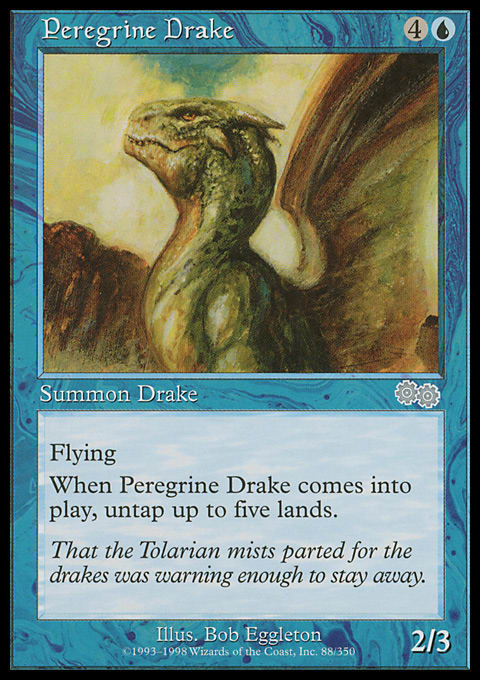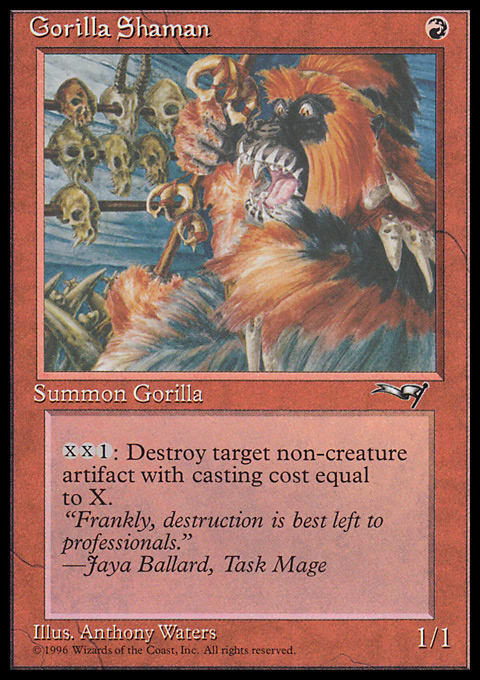Eldritch Moon is still a few weeks away from reaching Magic Online. In the interim it appears that Peregrine Drake will remain atop its Pauper pedestal. While this article will be published after the Banned and Restricted list update, I think there is merit in discussing exactly how this 2/3 flyer has changed the lay of the land. In order to fully understand the Drake though, we must examine it in the context of the creature it replaced, Cloud of Faeries.
Cloud of Faeries fit into two of the best decks in Pauper. In Delver, it helped to create a lock down opening sequence. A Delver of Secrets into a Cloud of Faeries was all but game over for multiple decks, as the assembled air force represented either a straight Counterspell or a Spellstutter Sprite. This line of play would allow the Blue deck to establish a board presence at almost no cost while also deterring an opponent from developing their game plan. Given Blue’s access to cards like Ponder, Preordain, and Brainstorm, it became rather easy for these decks to take over the game as early as the second turn.
Without Cloud of Faeries Delver decks remain a force. Faerie Miscreant has slotted in as the Spellstutter set up card of choice. While not nearly as strong as Cloud, the second copy will replace itself more often than not which helps to keep the deck moving forward. Simply put, in this format it is hard to keep a good Blue deck down.
Peregrine Drake has no application in a deck like Delver. It does not help to set up early plays and Delver can do better at the top end. Cards like Spire Golem, Stitched Drake, and Stormbound Geist are more desirable in that they are either tough to remove or provide an easy to cast clock. On turn four Spire Golem gives the Delver player far more options than Peregrine Drake, especially in a deck that may be setting back its own land drops with Gush. In fact, outside of combo applications the Drake is really just a mediocre creature.
And here is where Peregrine Drake and Cloud of Faeries overlap. The ability to untap lands and use them in conjunction with Ghostly Flicker and Mnemonic Wall/Izzet Chronarch/Archaeomancer to generate an unbound amount of mana AND enter-the-battlefield triggers are where these two creatures earn their keep. Cloud of Faeries needed cards like Azorius Chancery and Dimir Aqueduct to work and was often aided by Sunscape Familiar or Nightscape Familiar. In order to win the game the deck, Esper Combo, would use Sage's Row Denizen to mill an opponent from any number of cards to zero.
Peregrine Drake does not need as much help to win the game. Not only does it untap enough lands to loop Ghostly Flicker without the aid of cost reduction or extra mana, but it requires far fewer clicks (something to consider on Magic Online). Unlike Cloud of Faeries it is also a reasonable body that can end the game in short order.
Cloud of Faeries facilitates your win condition; Peregrine Drake is a win condition.
Some of the more successful Drake decks currently do not even run a true “spout” for the loops. Izzet Drake can include Rolling Thunder or Kaervek's Torch but it can get by just fine by generating enough mana to loop Lightning Bolts after softening up a life total with Drakes and Mulldrifters. Dimir versions have developed into the closest thing Pauper has to a true Prison deck, using Chittering Rats and Ravenous Rats to lock opponents out of fresh draws.
Izzet Drake ? Pauper | 5-0 Pauper League, Filippini
- Creatures (16)
- 4 Archaeomancer
- 4 Mulldrifter
- 4 Peregrine Drake
- 4 Sea Gate Oracle
- Spells (23)
- 3 Ghostly Flicker
- 4 Counterspell
- 4 Lightning Bolt
- 2 Firebolt
- 3 Compulsive Research
- 3 Flame Slash
- 4 Preordain
- Lands (21)
- 5 Mountain
- 8 Island
- 4 Izzet Boilerworks
- 4 Swiftwater Cliffs
- Sideboard (15)
- 4 Electrickery
- 2 Hydroblast
- 4 Pyroblast
- 1 Sage's Row Denizen
- 4 Stone Rain
Dimir Drake ? Pauper | 5-0 Pauper League, Hellsau
- Creatures (23)
- 3 Chittering Rats
- 4 Archaeomancer
- 4 Mulldrifter
- 4 Peregrine Drake
- 4 Ravenous Rats
- 4 Sea Gate Oracle
- Spells (16)
- 1 Recoil
- 4 Brainstorm
- 4 Ghostly Flicker
- 3 Preordain
- 4 Ponder
- Lands (21)
- 4 Swamp
- 5 Island
- 2 Evolving Wilds
- 3 Dimir Aqueduct
- 3 Dismal Backwater
- 4 Terramorphic Expanse
- Sideboard (15)
- 2 Recoil
- 4 Crypt Rats
- 3 Dispel
- 4 Hydroblast
- 2 Snuff Out
Looking at Peregrine Drake itself it does not rise to the same level of ubiquity as Cloud of Faeries in that it only appears in one macro-archetype, Drake decks. The hope was, upon release, that Peregrine Drake would be slow enough to allow decks to draw their answers. 5 mana means at least a few draw steps to find a Lightning Bolt but it does not appear this has been the case. Just like when Gut Shot entered Pauper with Modern Masters 2015, Bolt is simply was not fast enough to stop a deck wholly dedicated to going off. The amount of card selection available to Blue makes it easy to find redundant pieces so unless a deck is loaded to the gills with Lightning Bolts and copies of Snuff Out it becomes challenging to stop the Drake it its tracks.
Now this in and of itself is not a bad thing. On the surface, Pauper appears to have a diverse metagame. As of the time of writing, there are 11 different decks that have accrued over 3% of the undefeated metagame. Of those, five have between 5% and 10% of the field and there are two more that have tallied more than 10%. There are multiple other decks hovering around 3% so it seems that just about anything has a chance. I have made my spreadsheet available to the public here.
Once you start peeling back the layers and looking not at the decks but at the different strategies people are playing the numbers tell a very different tale. Peregrine Drake decks make up over 25% of the undefeated metagame. After two weeks of trending down (even dipping below 20% of the metagame at one point) the overarching strategy has surged back with two strong weeks. In order to fight Drake, a lot of players are looking to go under their clock.
Different aggressive strategies account for nearly 48% of the metagame with Affinity leading the charge at 10.22%. When Affinity sustains itself at the top of the metagame I always take notice since Gorilla Shaman has done good work in the past in helping to keep that deck in check. Even with Red decks surging in popularity (Goblins and a haste-based Red Deck Wins), Gorilla Shaman is not doing its job of blowing up artifact lands. Seeing the rise of Affinity, a strong contender but rarely a top 3 deck, made me stop and take a look at the statistics. Aggro is nearly 50% with Drake combo another 25%. What makes up the rest?
Delver decks (including Dimir Delver and U/G Threshold) make up almost 12% of the metagame and control decks (including Jeskai Midrange and Mono-Black Control) don’t even have 10% of the undefeated metagame. Tron outside of Drake variants is almost non-existent. Drake has managed to supplant every possible lategame, from Gray Merchant of Asphodel to Ulamog's Crusher, in a way that has forced control decks out of the format and pushed Delver to its lowest levels in years.
For comparison, during Shadows over Innistrad Mono-Black Control had over 8% of the metagame and it currently cannot reach 3%. When a card as transformatively powerful as Gray Merchant of Asphodel cannot make waves then it may be that something is wrong.
Now, it is still early. Drake has not been legal for six weeks, but it is not entering the format completely innocent. Cloud of Faeries has tread upon the same ground before and that card was only recently banned. I do not presume to know how R&D feels, but this quote from Adam Prosak on the Development Tumblr makes me think Drake will get the axe. When asked about developing Eternal Masters for Pauper, Prosak discussed the importance of limited play and key commons (citing Nimble Mongoose and Yavimaya Enchantress). Then he added:
“Finally, due to how our schedules work, Eternal Masters was finalized before Cloud of Faeries was banned in Pauper. I think that if I knew that we were going to ban Cloud of Faeries in Pauper, I would’ve been much less likely to include Peregrine Drake in Eternal Masters. I believe that Peregrine drake is weaker than Cloud of Faeries, but both cards lead to the same degenerate combination with Ghostly Flicker.”
When a Developer calls something degenerate, I tend to listen. Pauper should try and play with Drake as long as it’s legal because its time may be coming to an end.
























